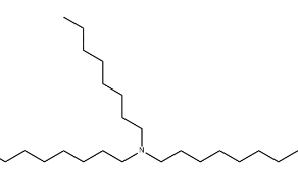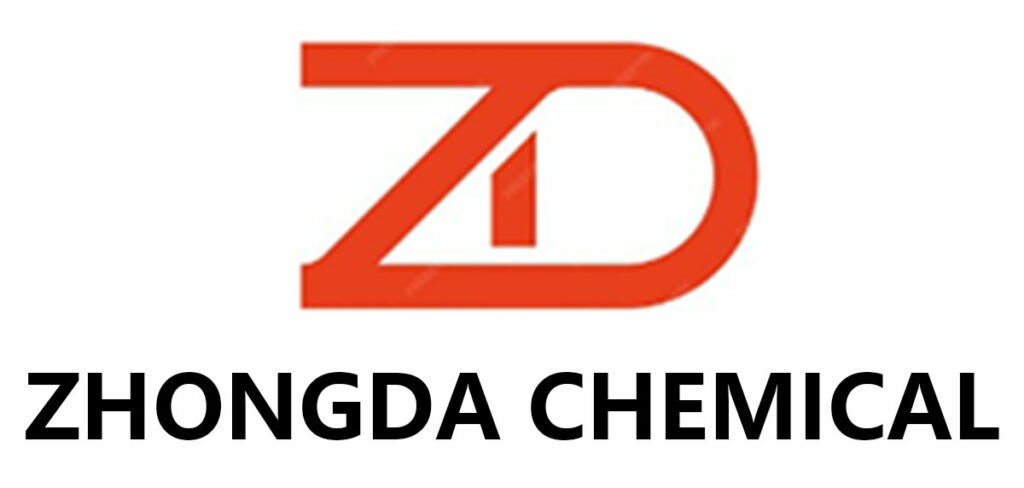Structure:
| Appearance | colorless clear liquid |
| Formula | C24H51N |
| CAS No. | 1116-76-3 |
| EC No. | 214-242-1 |
| UN NO. | 3082 |
| HS CODE | 2921199090 |
| Tertiary Amine % | ≥95 |
| Pri.&Sec.Amines | 2.0max |
| Main carbon chain % | 92.0min |
| Water % | 0.3max |
| Density(20℃)g/ml | 0.81 |
| Flash Point℃: | ≥147 |
| Refractive index: | 1.447—1.453 |
| Synonyms | Alamine336 |
TOA has the chemical formula C24H51N, and its structure consists of three n-octyl groups
(-C8H17) attached to a central amine functional group (-NH2). The long-chain alkyl groups
contribute to its hydrophobic nature.
TOA is a clear, colorless to pale yellow liquid at room temperature. It has a characteristic odor.
TOA is insoluble in water, but it is soluble in many organic solvents, including alcohols, ethers,
hydrocarbons, and chlorinated solvents. This solubility behavior makes it suitable for organic
solvent-based processes and extractions.
TOA is a weak base due to the presence of the amine group. It can act as a proton acceptor and
form salts with acids. The basicity of TOA can be utilized in various chemical reactions and
applications.
TOA exhibits selective solubility for metal ions, especially those of rare earth elements (REEs)
and actinides. It can extract and separate metal ions from aqueous solutions, enabling their
purification and concentration. The extraction efficiency and selectivity can be influenced by factors
such as pH, temperature, and the presence of other ligands or complexing agents.
TOA acts as a surfactant, which means it can reduce the surface tension between different phases,
forming emulsions and stabilizing them. This property contributes to its use as an emulsifier and
dispersant in various formulations.
TOA has a relatively high viscosity compared to some other organic solvents. The viscosity can affect
its handling and flow characteristics in different applications.
TOA is relatively stable under normal storage and handling conditions. However, it can undergo
degradation or chemical reactions under extreme conditions, such as high temperatures or strong
acids.
TOA is widely used as an extractant in liquid-liquid extraction processes for the separation and
purification of metals. It exhibits selective solubility for metal ions, especially rare earth
elements (REEs) and actinides. TOA can extract these metals from aqueous solutions and enable
their separation from other metals, facilitating their purification for various industrial applications.
TOA serves as a catalyst or co-catalyst in numerous industrial reactions. Its basic nature promotes
reactions such as esterification, alkylation, amidation, and condensation reactions. TOA can
enhance reaction rates, improve yields, and modify reaction selectivity in different chemical processes.
TOA possesses surfactant properties, making it useful as an emulsifier and dispersant. It can reduce
the interfacial tension between immiscible phases, stabilize emulsions, and aid in the dispersion of
substances in both aqueous and organic systems. TOA is employed in various formulations such as
paints, coatings, inks, and personal care products.
TOA has been investigated for its potential application in gas separation processes. It shows an affinity
for certain gases, including carbon dioxide (CO2) and hydrogen sulfide (H2S). TOA-based systems
have been studied for the removal of these gases from industrial gas streams, such as natural gas
purification and biogas upgrading.
TOA finds utility in analytical chemistry, particularly in the extraction and preconcentration of analytes
from complex matrices. It can selectively extract and enrich trace metals and organic compounds from
various samples, enabling their subsequent analysis and detection.
TOA is used as an additive in polymers and resins to modify their properties. It can enhance the
compatibility between different polymer phases, improve processing characteristics, such as rheology and
melt flow, and impart specific functionalities to the final polymer products.
TOA is employed as a solvent or co-solvent in organic synthesis reactions. It can dissolve and facilitate the
reaction of certain organic compounds, especially those with limited solubility in common organic solvents.
TOA can aid in the formation of reactive intermediates and promote desired chemical transformations.
The primary raw materials required for TOA production are n-octanol and ammonia. These materials need
to be obtained or synthesized to meet the desired specifications and purity requirements.
The production of TOA begins with the alkylation reaction, where n-octanol reacts with ammonia. The
reaction is typically carried out in the presence of a suitable catalyst, such as acid or base catalysts, at elevated
temperatures and pressures. The alkylation process results in the formation of tri-n-octylamine.
During the alkylation process, it is crucial to monitor and control reaction parameters such as temperature,
pressure, and reactant concentrations. This ensures the desired conversion and product quality are achieved
while maintaining safe operating conditions.
After the alkylation reaction, the mixture is subjected to separation and purification steps to isolate and purify
the TOA product. This may involve techniques such as distillation, extraction, or crystallization. The separation
process aims to remove impurities and by-products, resulting in the desired pure TOA.
Once the TOA product is obtained and purified, it is typically dried to remove any residual moisture. The dried
TOA is then packaged in suitable containers, ensuring proper sealing to maintain its quality. Adequate labeling
and storage conditions are maintained to ensure safe handling and storage of the product.
• Incoming inspection: The main raw materials,are inspected for their content, appearance and other
main properties.
• Feeding inspection: the principle of raw material feeding is first-in-first-out, and the appearance of the
main raw materials is randomly inspected according to whether there is a big change in the storage
conditions before feeding.
• Batch sampling in the production process: During the production process, the main indexes of each batch
of products: content and acid value will be examined three times in different time periods.
• Storage Inspection: Each batch (4tons) is inspected before storage.
• Outbound inspection: According to the quantity demanded by customers, the products will be sampled
and inspected.
• Pre-shipment inspection: according to customer’s requirement, third party inspection can be carried
out on the products before shipment.
• Physical Appearance: Visual inspection
• Purity Analysis:Gas chromatography (GC)
• Acid Value:Potentiometric titration
• Water Content:Moisture analyzers
• Refractive Index:Refractometer
• Density:Density meter
Each batch of products should be accompanied by a certificate of conformity, including: the name of the
manufacturer, the name of the product, the production batch number, the net weight per barrel, the
quality level and the implementation of the standard number.weight, quality grade and implementation
standard number.
Packed in clean and dry plastic drums, net weight 200±0.3kg per drum or 1000±0.5kg, compressed and
sealed after each batch.
This product is packed in plastic drums, during transportation and loading/unloading, it should be carefully
and gently put down, and prevent from impact.
The storage place should be cool, dry and ventilated. Do fireproof and rainproof.

The company pursues the concept of “continuous innovation, the pursuit of first-class”, and is willing to provide domestic and foreign customers with high-quality products and satisfactory service.